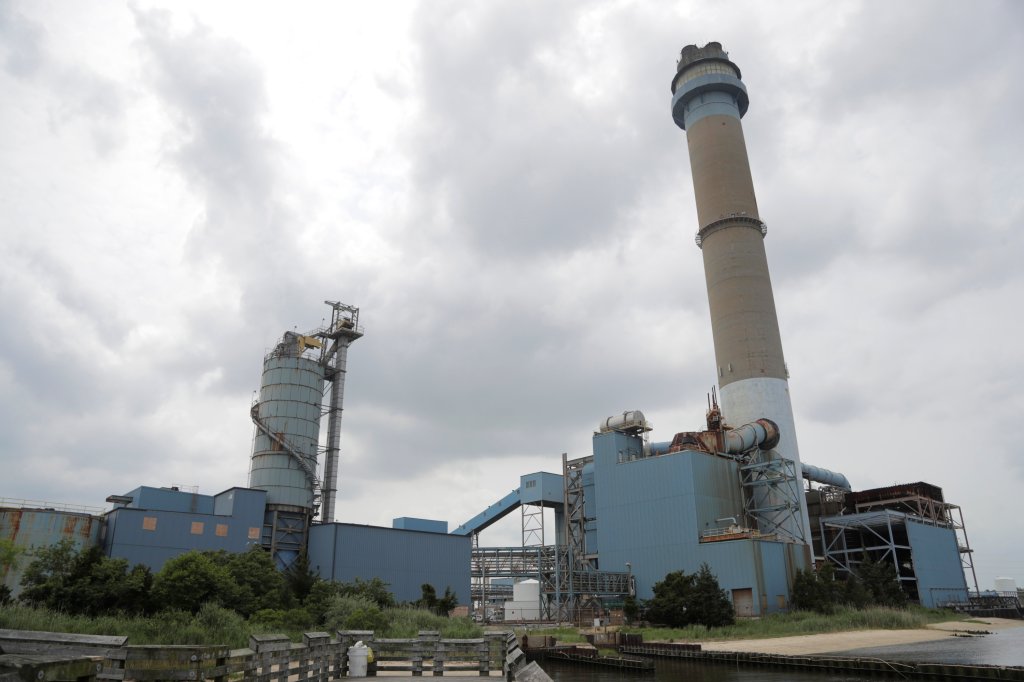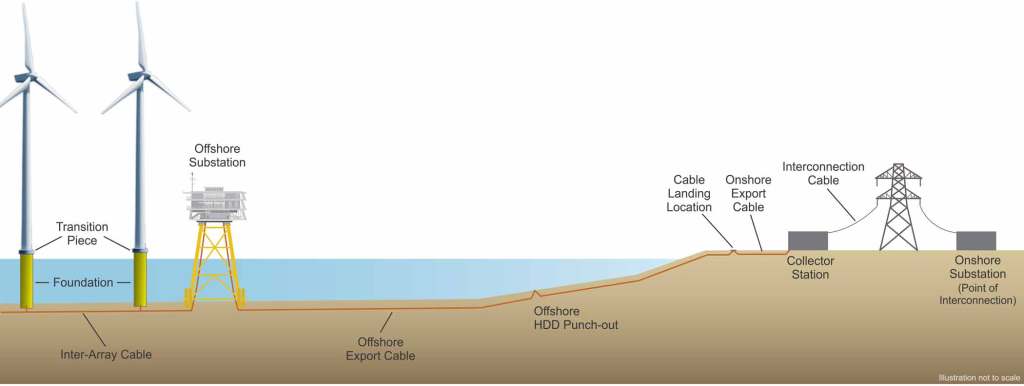One of the world's largest offshore wind developers, Denmark-based Ørsted, wants to bring 1,100 megawatts of electricity onshore from a wind farm in the Atlantic Ocean using a transmission line that would run through Ocean City, New Jersey.
That is not sitting well with some people in and around the small, but well-known Jersey Shore community, where many families across the Philadelphia region visit in the summer. Look no further than Kate Winslet's detective from "Mare of Easttown" for proof of Ocean City's popularity.
Still, it's becoming increasingly likely that Ørsted's Ocean Wind 1 project about 15-20 miles off Atlantic and Cape May counties will connect to the region's power grid with an underground transmission line that comes onshore at an Ocean City beach. It would then run through the community to a decommissioned coal power plant in nearby Upper Township.
Ørsted has claimed in recent public filings that Ocean City's local officials are ignoring the developer's requests for permitting approvals, but New Jersey's Board of Public Utilities can override municipalities and authorize a right-of-way for the transmission line.
"Ocean Wind requests that the Board (of Public Utilities) preempt and supersede Ocean City’s municipal consent with respect to any and all permits the Project must receive from the NJDEP, and conclude that the Project may obtain the necessary permits and approvals from the NJDEP," lawyers for Ørsted wrote last month to the BPU. The state body is currently considering Ørsted's proposal.
Here's what the route that Ørsted is requesting looks like:

A graphic illustration of the proposed transmission line connecting Ørsted's Ocean Wind 1 offshore wind farm in the Atlantic Ocean with a power station in New Jersey. The route runs through Ocean City, New Jersey. CLICK ON THE PHOTO TO ENLARGE IT. (Illustration provided by Ørsted)
The dotted lines in the graphic above are the proposed routes, with the black dot in the bottom center indicating an onshore connection at 35th Street. This is how Ørsted describes the transmission line route:
"Based on the route planning and site selection process, the Preferred Route would make landfall at the beach lots owned by Ocean City via HDD at 35th Street in Ocean City. The underground cable would travel west to Bay Avenue, north on Bay Avenue to Roosevelt Boulevard (County Route 623), west across Peck Bay (undeveloped area) at Roosevelt Boulevard Bridge (via HDD) and then continue on within the Roosevelt Boulevard right-of-way, turning north on State Route 9 (North 3 Shore Road) to the proposed substation property at the decommissioned B.L. 4 England. ... With the exception of the crossing of the beach lots east of 35th Street and the crossing of Peck Bay, the Preferred Route is sited within existing previously disturbed road right-of-way areas, thereby avoiding impacts to wetlands, water bodies, and residential and historic properties. The Properties ... are all proposed to be crossed via HDD. HDD landfall from the Atlantic Ocean will allow the Project to avoid impacts to sensitive resources such as beaches, dunes, and overwash areas. The beach is part of a beach nourishment project, which is not currently active, and HDD installation will allow for burial below the depth of closure while avoiding surface impacts."
HDD stands for Horizontal Directional Drilling, which is a method that drills a tunnel beneath while pulling and placing the transmission line into the tunnel.
At that Feb. 2 hearing, an Ørsted official said the "preferred route" for the transmission line would come onshore at the beach at 35th Street in Ocean City, then run under existing streets until it emerged a few miles inland at the former B.L. England coal plant.
"Compared to the potential alternatives, the Preferred Route is technically feasible, and has the least impacts to natural resources, including wetlands and water bodies, and residential and historic properties," Ørsted permit manager Pilar Patterson said in testimony to the BPU.
The onshore entry is suitable because it puts the transmission line on a nearly direct path with the former coal plant, B.L. England power station. The facility was decommissioned in 2019, but remains able to connect the offshore wind farm's power to the existing regional power grid, PJM.

A general view of the B.L. England Generating Station, the last coal-powered plant in New Jersey, Wednesday, June 5, 2019, in Upper Township, N.J. The plant, also known as Beesley's Point Generating Station, shut down operations on May 1, 2019. (AP Photo/Julio Cortez)
How exactly does an offshore wind farm like the two dozen in the works for the Atlantic Ocean off the United States coast link up with the country's existing power grids? Here's an illustration created by Dominion Energy, a Virginia public utility, that shows the transmission system Dominion is proposing for its Coastal Virginia Offshore Wind project. It's very similar to what Ørsted is proposing for Ocean Wind 1.

An illustration of the transmission line that connects a two-turbine offshore wind farm off the shore of Virginia. The pilot farm is owned and operated by Dominion Energy. CLICK ON THE PHOTO TO ENLARGE IT. (Illustration via Dominion Energy)
Ocean Wind 1 is on a current timeline to begin generating power from its 99 turbines by May 2024, according to Ørsted.
"In order for Ocean Wind to achieve the scheduled commercial operation dates, it must begin construction of the onshore portions of the Project by 2023," the developer said in its filings to the BPU on Feb. 2.
Offshore Wind Farms: The Lease Areas and Developers
Seventeen federally leased areas are off the coasts of eight U.S. states, as of December 2021. Click on each lease site to see how many turbines are expected or estimated, to which developer they belong and how much power will be generated. Turbine totals are either based on developers’ proposals or estimated using power generated by the largest turbine currently on the market.
That means New Jersey's BPU will need to rule soon whether the Ocean Wind 1 transmission line is approved for its Ocean City route. A spokesman for the BPU declined to comment on a timeline for a board ruling.
But he added that the BPU will make a decision only after more public discussion takes place.
"The Board has received a petition filed by Ørsted regarding landfalls associated with offshore wind generation. This petition will be considered by the Board as part of a transparent process, which will include public participation," BPU spokesman Peter Peretzman said in a statement this week. "The Board will have no further comment on this matter while it considers the petition."
An Ørsted spokeswoman did not respond to a request for more details about the timeline for Ocean Wind 1, but said in a statement prior to a public hearing on Monday night about the transmission line proposal that the developer will have more public hearings over the next couple years.
"The Ocean Wind project does not currently have any in-person public meetings scheduled, however, we do anticipate participating in public hearings and meetings required by federal and state permitting requirements," Ørsted's spokeswoman said. "The dates, locations, and agendas for these meetings will be provided through public notice in advance of the meetings."
Messages left for Ocean City's mayor and a city spokesman were not returned.
Many environmentalists support the offshore wind farms, and one of New Jersey's leading clean energy advocates said this week that transmission lines will not be a hindrance to communities like Ocean City.
"We should be celebrating the disappearance of dirty smoke stacks on the shore horizon, which will be replaced by responsibly developed offshore wind that will protect our oceans, help mitigate climate change, and free our communities from the pollution that comes from burning fossil fuels," Ed Potosnak, executive director of New Jersey's League of Conservation Voters said. "The cables will not be an eyesore; they’ll be deeply buried under the beach similar to the cables in the ground from utility and communications companies that we don’t notice."
Jersey Shore residents raised concerns Monday night during a public meeting on a warm farm project that would be installed miles off shore in the Atlantic Ocean.
"come" - Google News
March 10, 2022 at 02:59AM
https://ift.tt/LxTB94f
How an Offshore Wind Farm's Power Line Would Come Onshore in Ocean City, NJ - NBC 10 Philadelphia
"come" - Google News
https://ift.tt/2de6hrl
Shoes Man Tutorial
Pos News Update
Meme Update
Korean Entertainment News
Japan News Update
Bagikan Berita Ini














0 Response to "How an Offshore Wind Farm's Power Line Would Come Onshore in Ocean City, NJ - NBC 10 Philadelphia"
Post a Comment